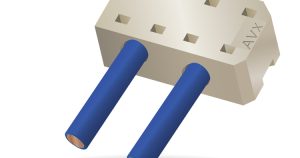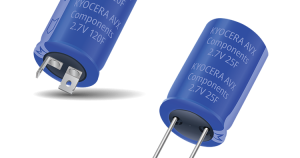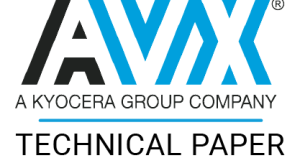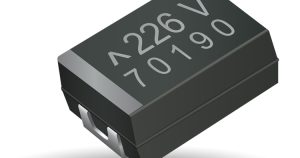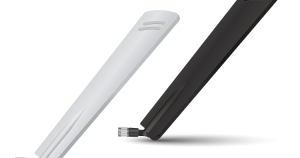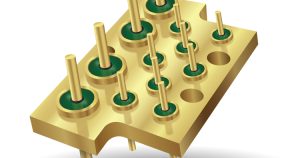Tantalum Capacitors: Characteristics and Component Selection Written By: Raul Wang Abstract: Capacitors are one of the fundamental building blocks of electrical circuits. Whether they are being used for energy storage, noise filtering, or timing/frequency design, capacitors are important in many common electrical devices. Today, various capacitor technologies are available, each with their own unique benefits and drawbacks, making each type ideal for different applications. Tantalum capacitors offer many interesting characteristics that combine to offer a unique solution to many design problems.
Technical Articles / Whitepapers
Connector Solutions for Automotive & Transportation Applications Written By: Matthew Lawrence Abstract: Wiring interconnect in the transportation sector continues to evolve at an extremely fast pace. Automotive technologies, largely driven by electric vehicles and self-driving systems, are placing particularly stringent demands on wiring connectors. On one hand, high-speed busses like automotive ethernet are reducing total wire weight and complexity. On the other hand, reliability requirements are becoming more demanding with 200,000-mile lifetime expectations and routine reliance on highly advanced sensor technologies such as radar and video.
Powering IoT Modules Using Solar Panels, SuperCapacitors, and an Automatic Buck/Boost Controller IC Written By: Ron Demcko | Ashley Stanziola | Daniel West Abstract: The use of IoT modules is exhibiting a high rate of growth because of their low cost, ease of implementation, and easily documented impact upon end-user efficiency, reliability, and cost. Manufacturers, installers, and end-users of IoT modules are seeking ways to power these devices and essentially create a set-and-forget module. Set-and-forget means a significant ongoing effort to eliminate batteries or extend the life of batteries powering IoT modules. Manufacturers of IoT modules are working to reduce their designs’ power consumption and also working with IC suppliers by requesting novel chipsets to provide quality power from harvested
Tantalum Polymer vs Aluminum Polymer Performance as an Output Filter Capacitor for Miniature Switching Power Supplies Written By: Ron Demcko | Ashley Stanziola | Daniel West Abstract: Engineers have questioned the impact performance of converting Aluminum Polymer capacitors to Tantalum Polymer capacitors in applications where MLCCs are present on the output filter ‘bank’ of a small switching power supply. The reasons for designers to convert to Tantalum Polymer capacitors in the design ranged from long term reliability and stability to availability/delivery and company specific design guidelines. This investigation is intended to compare the interchangeability of Tantalum Polymer Capacitors in a design with the original Aluminum Polymer capacitors. The data collected was the measured output voltage ripple on a highly utilized
Solid tantalum capacitors have a long history of proven performance in high-reliability military and space applications. But not all capacitors are created equal — even within the same class. As is the case with virtually all component technologies, materials matter. This paper will discuss the differences in performance and reliability between solid tantalum capacitors with manganese dioxide (MnO2) cathodes and those with conductive polymer cathodes. Bell Laboratories introduced the first solid tantalum capacitors to market in the early 1950s. The first military specification for surface-mount tantalum capacitors (MIL-PRF-55365) was released in 1989 and introduced CWR09-style components. Since then, the product offerings governed by this specification have expanded to include CWR19-style capacitors with an extended range of CV values and CWR29-style
AVX MLCC Flexiterm™: Guarding Against Capacitor Crack Failures Written By: Mark Stewart Abstract: The huge popularity of MLCC capacitors in comparison with alternative technologies is primarily a result of their superb reliability record and low cost. However, in certain circumstances problems can occur due to cracking in the ceramic portion of the component. These failures result from mechanical damage caused after soldering to the PCB; normally a consequence of PCB mishandling or when the assembly is located in extreme environmental conditions. This article outlines the main benefits and features of AVX’s ‘FlexiTerm™,’ a soft termination system that minimizes these failures by relieving the mechanical stress applied to the ceramic.
Connectivity is key in today’s world and devices in the market require strong signal strength to allow for peak performance. Integrating an antenna is not trivial, whether it is an off-the-shelf product or a highly customized solution, and should not be an afterthought.
The AVX antenna design team strongly recommends considering the antenna design and/or the antenna integration process as early as possible, ideally during the product design and the radio module selection. A perfect match between the radio and the antenna will ensure all wireless connectivity needs are met.
MLCC & TANTALUMINTERCHANGEABILITY Tantalum chip and Hi CV MLCC have a large degree of overlap in available capacitance ratings in common footprints. As MLCC production increased, many applications converted from tantalum to MLCC for many filtering, bypass, and hold-up applications. With the increasing demands seen for low voltage digital applications, tantalum electrolytic technologies have become a first choice for MLCC substitution. KYOCERA AVX is a leading international manufacturer and supplier of a wide range of advanced electronic components, including: capacitors, inductors, filters, and circuit protection devices. The KYOCERA AVX tantalum electrolytic division has maintained a leadership position in automotive, industrial, medical, space, military, consumer electronics, communications, and transportation markets for nearly 50 years. Maximum Available Capacitance by Case Size (6.3V):
EMI Filtering for High-Reliability Applications Amanda Ison KYOCERA AVX Components Corporation Electromagnetic interference (EMI), or electrical noise, is generated by everything from cellphones to solar flares and can make accurate signal transmission as difficult as trying to have a clear conversation in a noisy room. To improve signal clarity in electronic circuits, device designers turn to EMI suppression filters. Effective EMI filtering is necessary for almost every modern electronic device, including devices that generate their own EMI, as well as devices that are sensitive to EMI within their environment, and is especially important in high-reliability applications that utilize lower-power signals and have strict signal fidelity demands. High-reliability EMI filters are designed to consistently meet or exceed performance requirements and are
Temperature Stability Assessment of GaN Power Amplifiers with Matching Tantalum Capacitors Written By: Ron Demcko | Mitch Weaver | Daniel West Abstract: Wide band gap GaN and SiC devices are expected to experience high levels of growth in applications ranging from power conversion to RF transistors and MMICs. End users recognize the advantages of GaN technology as an ability to operate under higher currents and voltages. RF GaN market is expected to grow at 22.9 % CAGR over 2017-2023, boosted by implementation of 5G networks. [1] During the past years, the wide band semiconductors have reported achievement of >1000 V BDV that opens new challenges for high power industrial applications such as electric traction systems in trams, trolley buses or
High-Reliability Solid Tantalum Capacitors Bob Fairey AVX Corporation, One AVX Blvd, Fountain Inn, SC 29644www.avx.com Solid tantalum capacitors are among the most popular types of small, surface-mount capacitors for electronic applications across the consumer, automotive, aerospace, and medical device markets. This paper will provide some context on the development of tantalum capacitor technology and address issues frequently faced by users, including the need for low equivalent series resistance (ESR) in filtering applications and the need for the highest possible reliability and long-lifetime performance in aerospace and medical applications. Figure 2: The dielectric surface area of a tantalum capacitor anode compared to its finished size. Over the course of the following decades, tantalum capacitor technology evolved to include several form factors.
Polymer Tantalum Capacitors with Suppressed Transient Current Written By: Jan Petržílek | Miloslav Uher | Jiří Navrátil Abstract: Tantalum electrolytic capacitors are renowned for their high capacitance and volumetric efficiency, parametric stability over a long service lifetime, and long-term reliability under harsh operating conditions. The anode is constructed of a porous pellet of sintered tantalum powder with a dielectric of tantalum pentoxide formed by electrochemical anodization. The traditional cathode materials have been either a liquid electrolyte (wet hermetic types) or manganese dioxide (solid MnO2 surface mount types). However, the most recent material, fast becoming a popular option, is conductive polymer. The Polymer Tantalum capacitor was originally marketed toward consumer electronic applications, however after years of effort and continuous improvement, significant
Increasing Reliability of SMD Tantalum Capacitors in Low Impedance Applications Written By: David Mattingly Abstract: High dv/dt conditions in low impedance circuits using surface mount tantalum capacitors is discussed. Circuit designs utilizing low R(DS)ON MOSFETs for preventing these conditions are presented in detail.
Voltage Derating Rules for Solid Tantalum and Niobium Capacitors Written By: Tomáš Zedníček | John Gill Abstract: For many years, whenever people have asked tantalum capacitor manufacturers for general recommendations on using their product, the consensus was “a minimum of 50% voltage derating should be applied”. This rule of thumb has since become the most prevalent design guideline for tantalum technology. This paper revisits this statement and explains, given an understanding of the application, why this is not necessarily the case. With the recent introduction of niobium and niobium oxide capacitor technologies, the derating discussion has been extended to these capacitor families also.
Ultrathin Discrete Capacitors for Emerging Embedded Technology Written By: Radim Uher | Tomas Zednicek Abstract: Passive components can represent as much as 70% of PCB footprint in today’s electronic systems. The development of a suitable technology whereby integrated passive components are embedded into the PCB body has been one of the key trends in downsizing for more than a decade. Latest achievements have allowed the implementation of this ‘embedding technology’ into pre-production and even mass production. The next step requires the involvement of the complete supply chain, including traditional passive component manufacturers. This paper will present the state of the art in the development of ultrathin discrete capacitor technology and discuss the challenges of overcoming mechanical, electrical and thermo-mechanical issues
Thermal Management of Surface Mounted Tantalum Capacitors Written By: Ian Salisbury Abstract: This paper covers thermal management of surface mounted tantalum capacitors, and explores the thermal characteristics and how these are modified by the thermal interconnection substrate. The paper explores the different methods of mounting to reduce the thermal resistance to the PCB, also the affect of the design of connection pads on the PCB to reduce the thermal stress on the capacitor.

